





This article is an introduction to this common and highly ornamental cycad known as the Sago Palm (NOT a palm by the way). Included are suggestions on how to grow and reproduce this excellent potted as well as landscape plant.
Probably the most commonly grown cycad around the world is Cycas revoluta, commonly known as the Sago Palm. This unfortunate common name has led many to believe this is a palm when it is not, and sometimes when treated like a palm, it does not perform as well as it should in cultivation. However one of the reasons for its popularity is its tolerance of abuse (such as treating it like a palm). The other reasons for its popularity include long life, slow growth, neatness of appearance, excellence both in pots as well as in the ground, cold, heat, wind and drought tolerance and availability. This plant was my first cycad and had it not been so easy to take care of, I might not have gone on to collect more cycads and develop my interest in these sorts of plants. The following is an introduction to this plant as well as suggestions on how to grow it, move it, trim it and keep it from being a problem (injury, toxicity, looking bad etc.).Other names for Cycas revoluta are King Sago Palm, King Sago Cycad and Japanese Sago Palm. These names sometimes lead to confusion as there are several similarly named plants. For example, there is a ‘real' Sago palm (Metroxylon sagu) which is a very large, tropical, swamp-loving palm from tropical Asia that looks and grows nothing like a Cycas revoluta. And King Palms are very commonly grown true palms from Australia that one will often encounter at home garden outlets stores that also look and grow quite differently from Cycas revoluta. And sometimes King Sagos can be confused with another common cycad, Cycas circinalis, which also is sometimes called a King Sago palm or a Queen Sago Palm.
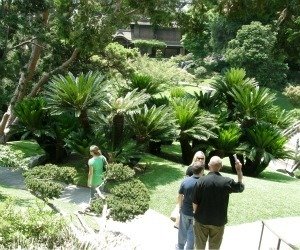

shot of Cycas revolutas in the landscape at the Huntington Gardens near Pasadena, California (left) and true Sago Palm (Metroxyon sagu), a very tall, extremely tropical palm that lives in the swamps of Asia (right).
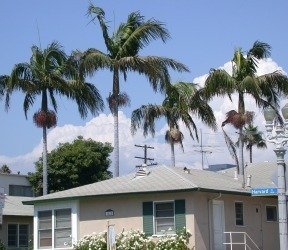
Sometimes Cycas revolutas are erroneously referred to as King Palms, which are true palms and completely unrelated to cycads. This shot shows some mature king palms (Archontophoenix cunninghamiana) in Los Angeles
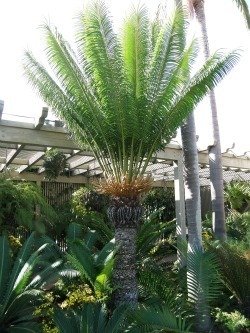 Cycas circinalis, the Queen Sago, is sometimes erroneously called the King Sago.
Cycas circinalis, the Queen Sago, is sometimes erroneously called the King Sago.
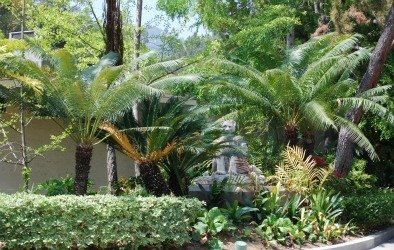
This shot shows both Queen and King Sagos in the landscape (the Cycas revolutas are the shorter, greener cycads in the center)
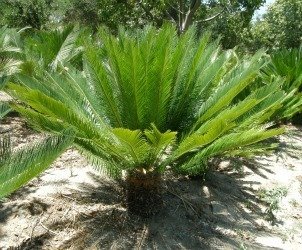
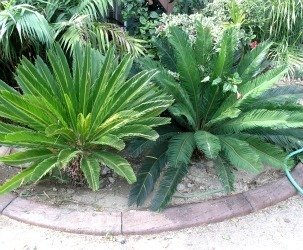
Cycas taitungensis (also sometimes called a King Sago) is a rapidly becoming popular cycad that looks a lot like Cycas revoluta except that it grows much faster and larger and has flat leaves rather than 'Vd' leaves on cross section. Shot on right or below shows both plants in a garden with the Cycas revoluta on the left and Cycas taitungensis on the right
As mentioned above, the Sago Palm is a cycad, not a palm. Palms are flowering plants and trees, usually native to the tropics, and are completely unrelated to cycads despite their somewhat similar appearance. Cycads are an ancient plant form, evolved many millions of years before there were even dinosaurs on the planet. Like conifer trees (distant relatives of the cycads), cycads do not reproduce by flowers, but have cones instead. All cycads are dioceous, meaning they are either male or female so their cones produce either pollen or seeds, never both. Unfortunately you cannot tell what sex your Sago Palm is unless it either makes a cone (the two sexes are then very easy to tell apart), or your plant is an offset or sucker from another plant (and you happen to know what sex that plant is).
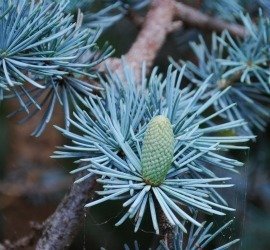
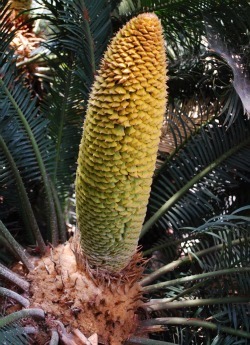
Relatives: on left a cone from my Atlas Blue Cedar (a conifer); and right is a male cone from a Cycas taitungensis (related to Cycas revoluta)
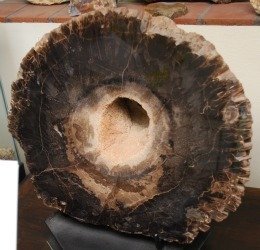
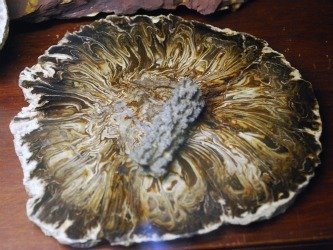
Two examples of cycad fossils from before the time of the dinosaurs
Description
Cycads grow more like succulents than they do like palms. Their stem or caudex is a large, fleshy, somewhat woody support structure. It is not a water storage structure as many might think, but acts more as a typical stem transporting water upwards towards the growing center (apex or tip of the plant) and food back down to the roots. The stem does store some energy, but it's the roots that are the more succulent-like structures (particularly in young plants), allowing a Sago Palm to survive longer periods of drought than the average plant might.
Stems can eventually branch with age, or from damage to the growth center. Sometimes suckers develop off the trunk and eventually turn into branches, too. But most suckers develop from the stem just below ground level. Old cycads can consist of numerous stems creating an actual thicket of spiny leaves and rough-textured trunks.
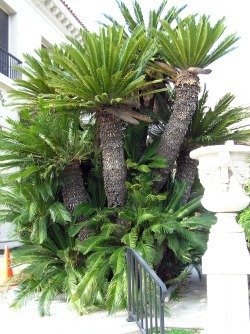
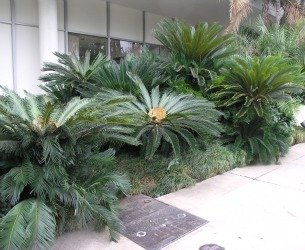
large old plant (s?) at the Huntington gardens showing not only aggressive suckering and resulting large shrub, but also some branching (left) and a healthy colony of plants in front of a hotel in Los Angeles (right)
Like all cycads, Cycas revolutas grow from an apical meristem or growing center at the top, center of the stem. From here new leaves from and grow out in a radial fashion forming a perfectly symmetrical crown of leaves. This radial symmetry is one of the reasons Cycas revolutas are so ornamental and loved by professional landscapers, bonsai specialists to amateur plant growers and collectors alike. The reproductive cones also arise from this apical meristem. Each ‘flush' of leaves is followed either by another some time later, or a cone (hard to predict which most of the time). The larger and more well watered the cycad, and the warmer it is kept (to a point) the more flushes of leaves one will produce a year. However, this is still a pretty slow growing plant, taking many years to grow from a seedling to even forming a trunk. They can grow for over 100 years and very old, tall cycads are prized collections, often passed down several generations. A Sago Palm's slow growth is one of the reasons it makes such a good house or bonsai plant. And as a garden specimen, it can take decades to grow to a point where one might need to trim it back or remove the offsets to keep it from outgrowing its spot in the garden.
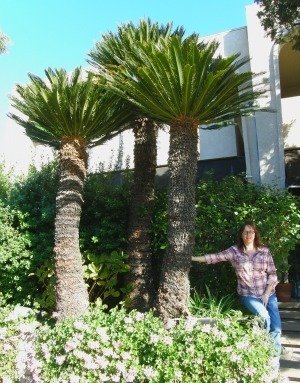
These three plants are probably close to one hundred years old if not more
The leaves of the Cycas revoluta are deep, glossy green and nearly plastic-like in texture, growing up to three to four feet in length (in very old and shaded specimens). Plants grown in deep shade can develop leaves even longer than that. The leaflets are needle-like and reminiscent of their pine-needle forming relatives, the conifers. However Cycas needles have a distinctive midrib. These leaflets arise off either side of the rachis at a distinct ‘V' angle in cross section as well as a ‘V' when looking down at the leaf. The leaflets themselves also have a bit of an arch to them as they bend slightly back towards the plant near the tips- this is an example of a revolute leaf shape (hence the name ‘revoluta'). New leaves that are just flushing from the center are pale green, soft and slight fuzzy. The leaves are very delicate at this phase and should not be handled or they may break off easily or grow into deformed shape. As leaves age, they yellow and eventually turn brown, dry and may fall off given time. Most trim them off at this point, however. Old Sago Palms have very rough stems armed with sharp leaf bases (though most eventually fall off). The base of each cycad leaf has somewhat shortened leaflets that are extremely sharp and stiff making their handling without gloves a bit risky and uncomfortable.
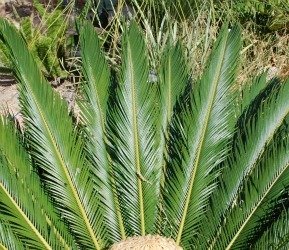
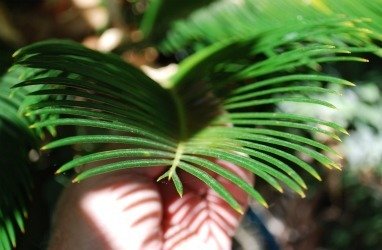
Cycas revoluta leaves from above (left) and from the end of the leaf, showing the subtle 'V' of the leaflets coming off the rachis (midrib of the leaf) on right
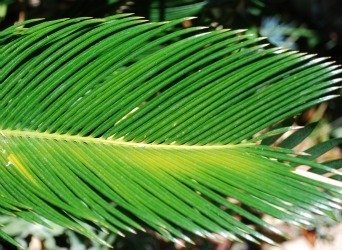
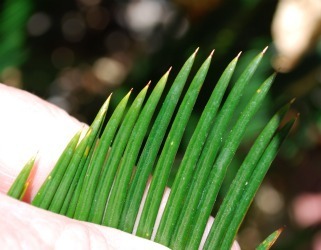
closer shots of the leaf of a Sago Palm (left or above) and even closer of the needle-like tips of the leaflets and grooves down their centers (right or below)
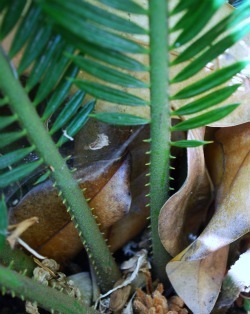
As one gets close to the leaf bases, the leaflets get stiffer, shorter and sharper, making pruning these leaves a hazard. One can also see the typical short spines at the very bottom of the leaves seen on most Cycas species. These spines are also very sharp
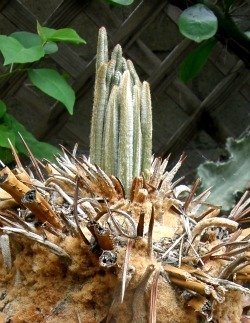
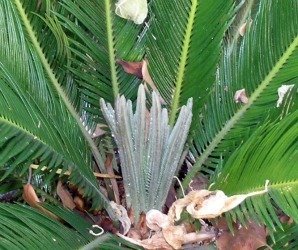
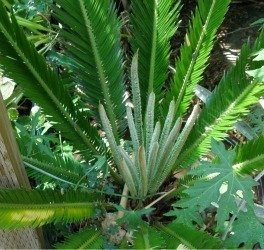
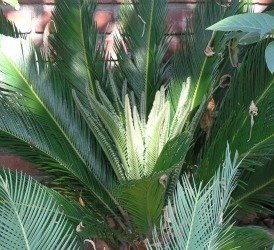
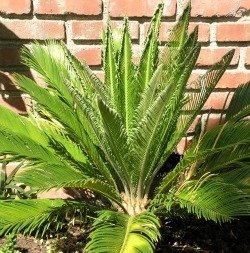 above photos show progress of new leaves
above photos show progress of new leaves
Care of Plants in the ground
In many climates throughout the southern US Cycas revolutas can be grown in the ground. Well draining soil is recommended, but these plants are fairly tolerant of clay soils as well and seem to adapt pretty well to many different soil types. Temperatures below 15F briefly can be damaging to the leaves, and below 10F to the stem as well. If exposed to such low temps for longer periods of time, the stem may be permanently damaged. Temperatures over 110F for a long period can damage the stem as well, and hot, dry sun exposure will sunburn the leaves (making them unsightly, but will do little damage to the health of the plant).
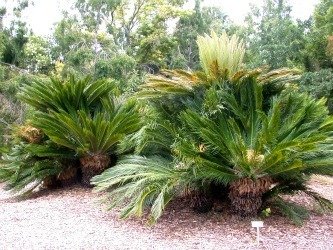

Growing in the ground in Fullerton, California, and in the snow in Seattle, Washington (right or lower photo by cazieman)
Watering newly planted plants with little or no root damage should be done immediately after planting and at least weekly as long as soils are fairly well draining. Once established, watering can be more or less often depending on the weather and how fast you want your plant to grow. These plants are fairly drought tolerant once established and can go for months without water unless soils are very sandy and/or temperatures are hot and dry. Watering frequently in cold weather while growing in poorly draining soils can sometimes lead to root rot, but this is more of a concern with young plants than older, well established ones.
Trimming off yellowy, older leaves as well as the dried, dead ones is recommended to keep plants looking healthy. Trimming all leaves off plants may be necessary at times if plant got too dried out, or had a bad attack of scale, or for any other situation in which all the leaves died for some reason. Removing all leaves from a well established or larger plant rarely seems to have an effect on the overall health of the plant. Even young plants usually tolerate leaf loss, but it sets them back more. Removing leaves from plants suffering from nutritional deficiencies is not recommended, however, as this may worsen the plant's overall health.
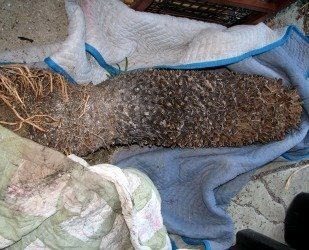
Plant I dug and and moved to my yard about four and a half feet tall... I cut off all the leaves and they regrew eighteen months later.
When planting a Cycas revoluta in your garden, it is best to select a spot where water does not collect (do not plant in a ditch). If you live in a climate that is arid and hot, protection from afternoon shade is best. However, plants growing in deep shade will get etiolated and weakened eventually and may be prone to rot so generally as much light as your climate will allow is best. Here in California most Sago Palms do fine planted in full sun, though those planted inland can get a bit yellowy in late summers from sun damage to the leaves. Plant thinking of the future as these can grow to be fairly wide (so not right next to a high traffic area). They can get tall, too, but generally not too tall in one's lifetime. I have seen some Cycas revolutas in Los Angeles over fifteen feet tall but I think those plants are well over one hundred years old.
When putting a plant in the ground it is best to plant at the same level the plant was in the pot or box. There is no reason to put the plant in more deeply and this can end up allowing the caudex to rot. There are many cycads with subterranean caudeces, but this is not one of them. There is little unique to planting Sago Palms. Plant as you would most other plants in the ground, digging a hole larger and deeper than the pot. Plants that have been kept in a pot for a long time tend to be somewhat root bound, so care should be taken to remove the pot without tearing off too many roots. Root-bound plants however, plant fairly easily with minimal setback normally.
Planting large plants can take multiple people as these can get well over a thousand pounds. I have planted a few large plants that weighed several hundred but I have no personal experience moving box specimens (usually a crane is involved). The larger the plant, the more careful one has to be not to damage the delicate stems. A cracked stem can mean death of the whole plant, so these need to be moved with some support and gently. Minor cracks or damage to stems will usually result in a leaking of a self-sealant these plants naturally produce (a clearish gel-like matieral).
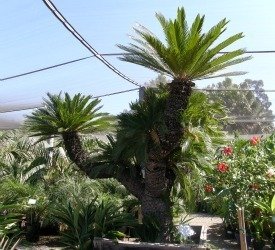
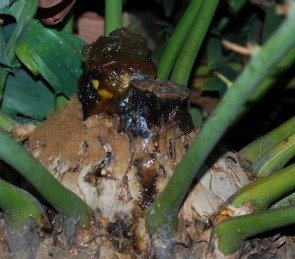
moving and planting this huge boxed specimen will take help and possibly a crane to do it successfully. Right or lower photo shows goo that comes out after cutting or injuring a Sago Palm- sort of a self sealant material.
Root damage in Sago Palms is less of a concern, but the less root damage the better. However cutting all the roots is likely to end in death of the plant. If one is moving a smaller plant and cuts or damages a root, it is best to treat the cut end with rooting hormone and/or some antifungal goo or sealant to protect the surface from fungal infection. These plants should probably not be watered right away, either. Large plants can easily survive for many weeks without being watered and this may give them time to heal over their root injuries.
When moving larger plants, one must be careful not to get injured. Sago Palms have lots of sharp parts. For convenience sake, I usually cut off all leaves before trying to move one of these, though this decreases the plants ornamental appeal for many months or even years, so avoid this if you are doing some professional landscaping. The trunk can also do quite a bit of damage, too, so one should wear long sleeves as well as gloves.
Some plants experience set back after being moved about and may not put out a new set of leaves for over a year (I had one that took two and half years to start growing again, but it is fine). The less root damage, the less set back.
Care of plants in pots
Cycas revolutas perform very well in pots and since they are so slow growing, they do not need to be potted up very often. The soil ingredients of potted plants are much more important than they are in garden-planted plants. Just because these cycads will tolerate somewhat poorly draining soils, or even sandy soils in the garden does not mean they will do well in the same soils in pots. Potted soil should be fairly rich, well draining (but not too well draining or plants desiccate easily) and should have either some slow release fertilizer, or you will need to be fertilizing these plants regularly (2-3x a year outdoors and maybe yearly or less indoors).
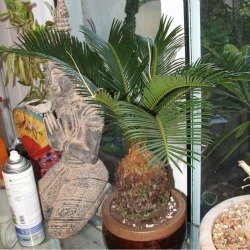 My own sun room plant happily living in a small pot
My own sun room plant happily living in a small pot
Though these tend to be relatively decent indoor plants, they do need a lot of light (the more the better, though full sun through a window can be a bit harsh). Plants grown in darker rooms develop long, weak leaves and are more prone to rot if even slightly overwatered. As slow growing as these plants are, they are even more so indoors. So plants seem to never outgrow their pots. One must make an effort then to change the soil every two to four years and leach it out every 4-6 months or too much salts will accumulate and damage the roots. Fertilizing should be yearly or less for most indoor plants.
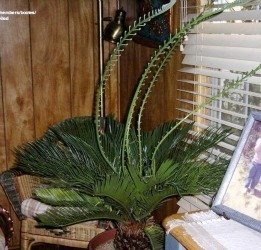
This indoor plant is in too low a light evidenced by the bizarre, etiolated new leaves coming out two to three times as long as the pre-existing leaves (photo by bootes)
Root binding is not a huge concern with most cycads, but it does slow their growth down significantly (which may be a good thing for a potted plant). However, cycads do not like being root bound as much as most commonly grown potted palms do, so eventually one will need to pot their Sago Palm up a size or two (palms seem to be happy in most pots until they get so root bound there is either no soil in them, or they break the pot apart).
Bonsai Care
These plants can do very well in surprisingly small pots, though one either has to grow them into that size or root prune them carefully to fit them in such shallow pots. Once they are set up, soil should be kept fairly moist. Bonsai plants do not tolerate getting too dry, and like all plants used for bonsai, desiccation is the most common reason for failure. Even this species, which is relatively drought tolerant, can easily die if let dry out too long. Humidity also can be helpful for bonsais though it seems to matter little for Cycas revolutas grown in normal pots or in the ground. Misting regularly can be helpful as can a catch basin below the pot (aka humidity tray). While one can get away with rarely fertilizing in ground plants (except in particularly sandy or deficient soils commonly found on the east coast), or yearly in most potted plants, these should be fertilized four to five times a year with a diluted liquid fertilizer. Prune old leaves after each new flush.
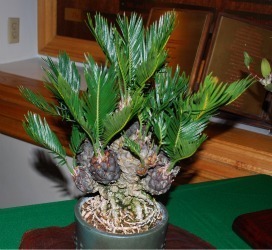 Nice bonsai Cycas revoluta at plant show
Nice bonsai Cycas revoluta at plant show
Sago Palm propagation
Cycas revolutas can be reproduced in several ways. The easiest is just to take the suckers/offsets and root them. This gives one a huge head start over growing cycads from seed and it also gives one a good idea what sex of baby cycad they have (as long as the adult has coned at this point). Offsets can be removed from along the base with either a sharp trowel or some sort of garden knife. Even if you don't want more cycads, removing offsets will keep your plant growing faster and looking more elegant. The larger the offset, the more easily it will root (large ones may have some roots of their own already). Very old plants may start offsetting along the trunk. One may not have the luxury of waiting for these to get really large as they may start to form a branch and then your cycad may become huge and ungainly. But super small offsets from trunks can be a bit tricky to root. Applying rooting hormone to these smaller offsets and letting them ‘dry out' a week or so will make them less like to rot in a rooting medium (usually perlite or pumice and something else- sphagnum moss, sterile potting soil, sandy mix etc.). Most offsets will root within six to twelve months. Check periodically for softness (NOT a good sign). Immediately remove rotting or soft offsets to keep the fungus from getting to the other plantlets.
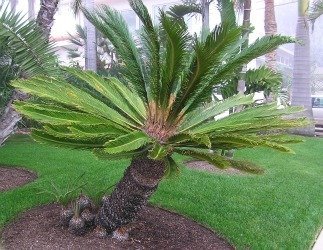
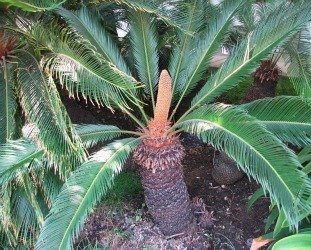
Plant showing suckers around base (left or above) and much older plant with trunk covered in small suckers (right or below)
Growing cycads from seeds is a bit more fun but this takes a lot longer and requires two different sexed plants. If you only have one plant, you will not get viable seed (seed from a female plant without a male around will never germinate). But if you happen to have many maturing plants, chances are you will have at least one male and female in the group. Thankfully most Cycas revolutas cone about the same time of year (mid to late spring). However, if you have a male cone and no females are ready, you can store the pollen in small paper envelopes in the freezer for years and it will usually remain viable. By the same token you can get pollen from someone else's plant this way if you only have a female.
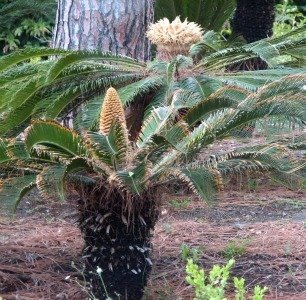
mature male and female cones at the same time late spring, Los Angeles (male plant in front and female in back)
Male and female cones are easily to tell apart- more so than with most other genera of cycad. Cycas species have unique female cones that are often erroneously referred to as ‘flowers' since they are large mound-like structures with many ‘petal-like' parts throughout the mound. No other genus of cycad has female cones like these. The male cone is a taller, slenderer structure that looks a lot like a huge version of a cone one might encounter on many different kinds of conifer.

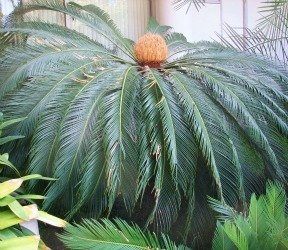
Male plant on left or above and female on right or below
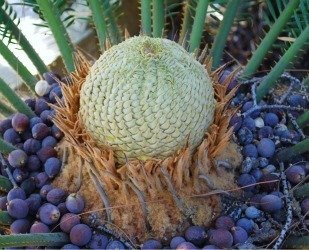
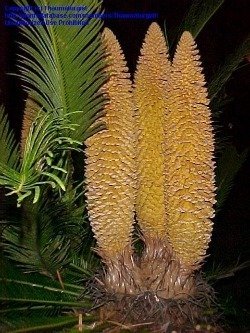
early male cone on left or above and mature on right or below (right photo Thaumaturgist)
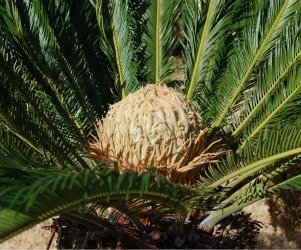
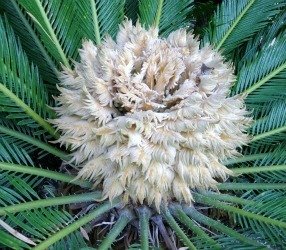
early female cone (left or above) and open, receptive female cone (right or below)
Male cones mature to the point where they start to open up (you can see the spaces between each scale). This is a mature cone and pollen can be obtained from it by cutting it off at the base and shaking it either over a ready female cone, or over a piece of paper. Then the pollen can either be stored or taken over to the female cone and dropped on it when it's ready and open, too. Female cones develop from relatively smooth looking mounds to spikey, flower-like structures. To improve the chances of fertilization shaking some pollen on the open female cone should be done over several days. The natural pollinators for Cycas revolutas do not exist in the US, but sometimes ants or even wind can do the job accidentally, so even if one does not actively pollinate a female, a few fertilized seeds may grow as long as one has both a male and female coning at the same time in proximity.
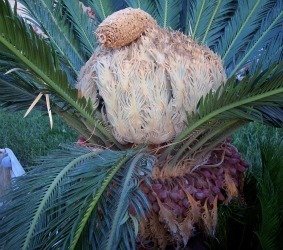
one method that seems to work pretty well, particularly with Cycas species, is to cut off the open, pollen-producing male cone on top of the open, receptive female cone and let the pollen fall off where it may.
Seeds will turn from yellow to orange (even if unfertilized) over the summer and eventually develop to the size of a somewhat flattened ping-pong ball by winter time. By the end of winter, the seeds will be as large as they are going to get and should be harvested. Usually ripe seed grows larger than unfertilized seed and it also should sink in water (unfertilized seed usually floats).
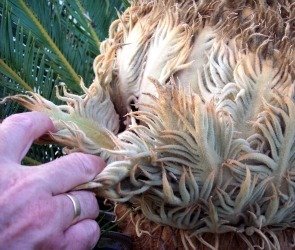
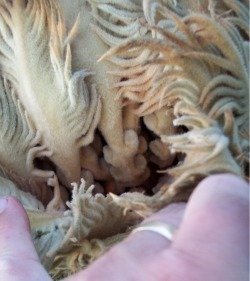
looking for seed in a fertilized female cone (left or above) viewing the early seed formation (right or below)
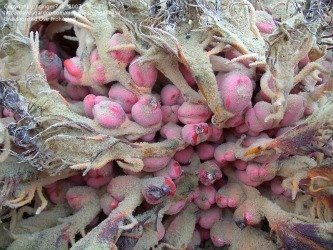
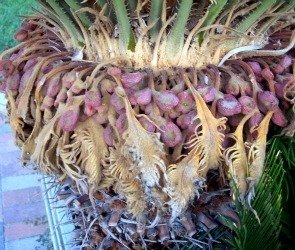
seed turning orange (left or above photo ginger749) Old seed that was not fertilized and a new flush of leaves on top (right or below)
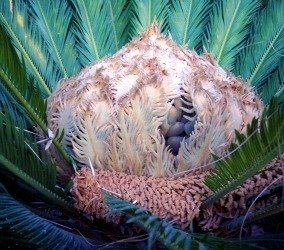
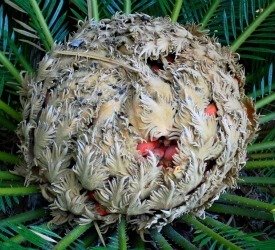
fertile seed developing (left or above) and almost ripe (right or below)
Seeds need to be cleaned (the orange fruit should be removed), and then dried for a few days. You can either plant the seed now or store a few months in a cool dry place. But then you will need to soak it a few days before planting it.
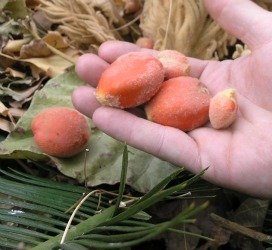
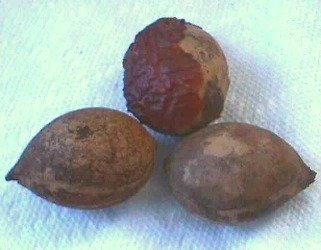
ripe seed and unfertile seed (left or above); cleaned seed (or partially cleaned above) right pr below photo htop
Some grow seeds in large community pots with very well draining but moisture retained medium, deep enough to allow good root formation. Others grow their seed in warm humid greenhouses on top of a layer of pure pumice until the seeds send a root down a few inches, and then move them to individual pots (this is particularly done with more expensive, delicate and rare species). If you are going to use the community pot of flat technique, it is easiest to plant the seeds about half way to ¾ way into the soil on their sides (flattish sides up and down, not with one of the narrow sides shoved straight into the soil).
Do not try to grow seeds in full sun as they will dry out too easily or the seedlings will fry. Sago Palm seeds and seedlings do not necessarily need a greenhouse to be grown in and extra heat does not seem to be necessary to grow this species... but it can help, particularly if you are growing these in winter in a cold climate. Keep soil moist the first year.
Toxicity
Like all cycads (as far as I know), Cycas revolutas are toxic. Basically all parts are toxic, though the fruits seem to be more toxic than the rest of the plant. This might surprise some since 'sago' is an edible starch extracted from the trunk of Sago Palms (as it is from many 'real' palms as well). Though historically a cheap source of sago, there have been several methods adopted in processing this sago to make it less toxic. However, eating sago from Cycas revolutas (and many other species of cycad) have still been associated with many cases of human poisoning.
From a veterinary point of view, Cycas revolutas are one of the most significant sources of pet poisonings in the US (and perhaps around the world). The reason for this is not only the very toxic substance (Cycasin) present in most parts of the plant, but also the Sago Palms' unusual lack of a bitter or bad taste, so characteristic to most of the world's toxic plants species. There are at least a dozen more toxic commonly grown garden plants than Cycas revoluta, and long lists of many hundreds more toxic plants found in many gardens throughout the world, but all of these other plants (with a few exceptions) taste terrible and are only eaten by the most determined pets in large enough quantities to result in significant poisoning. And thanks to this plants' rising popularity and ubiquitous presence in nearly all nurseries, pet cycad poisonings are on the rise. This plant is probably associated with a higher percentage of pet dog fatalaties than from any other toxic plant ingestion. So if you have curious pets (dogs primarily) or young children for that matter, please be very careful with exposure to these household members with this plant (and all other cycads as well).
Problems
Poorly draining soils can lead to root rot (or even rotting of the lower part of the trunk). This is not a common occurrence in planted Sago Palms unless there have been climatic extremes beyond what is recommended, or the plants are planted in swamps. These are pretty tolerant of wet, sloggy soils or they would not do so well in California clay. This is more likely a problem in pots. If noticed early enough, one might be able to save the plant by removing the roots from the pot and cutting off any thing rotten, treating the cut ends with fungicide and rooting hormone, and letting the plant dry out for a week or two on a dry table before replanting. I have saved many myself this way. However, once the stems starts to rot, there is little turning back unless one does an extreme surgery and removes all the soft and necrotic stem tissue and has a lot of patience (hard to get these to recover completely).
Crown rot from overhead watering is a fairly common problem in shade-grown plants. It is far better to water most palms and cycads with drip or low emitters that do not touch the sensitive growth centers of these plants, especially in cool or cold weather and in shade. If caught early enough and the rotting tissue removed and treated with antifungals, some plants will recover. However, they may set back for a very long time, and start growing abnormally from that spot (eg. branching).
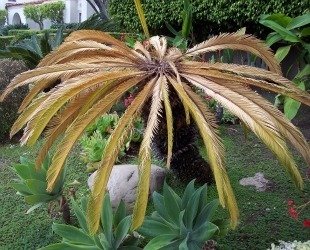
Desiccation is also reversible if one gets the plant watered at the earliest symptoms (usually wilting or loss of all the leaves). Desiccated plants have to be coddled for a while as often there has been significant root necrosis and overwatering at this time will be far less tolerated.
Nutritional problems are pretty rare on the west coast, but in the sandier soils of the east coast, Magnesium and Nitrogen deficiencies can be fairly common. Nutritional problems are not uncommon in potted plants, either. These are usually evident by yellowing of new leaves or patchy leaf necrosis. Frizzle top is a specific disease resulting in the new leaves being frizzled and brittle and is caused by Manganese deficiency. Note that yellowing of leaves is not a very specific symptom however and many things from overwatering to too little or too much light can also cause a variety of yellowing of the leaves. Usually all deficiencies can be fixed with adding of some iron sulfate and a good, well balanced fertilizer. For those plants growing in sandy soils, this may have to be a monthly routine.
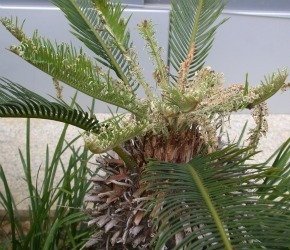 frizzle top
frizzle top
Sometimes OVER-nutrition can be a problem (excessive fertilizer or fertilizer burn), usually resulting in the tips of the leaves turning brown (or death of the plant in severe cases). I have found most cycads to be fairly resistant to fertilizer burn, at least compared to true palms, but it can still happen so careful.
Cycads are pretty tough and not very tasty plants, but they still have their share of pests and parasites. The most important one is probably the Asian scale (aka Aulacapsis Scale), which is quickly becoming a widespread problem even on the west coast of the US where it was not seen until recently. Most scales are more annoying than anything else can be easily killed with most plant pesticides (though the scale itself remains even after death- needs to be wiped off by hand then). But Asian scale can quickly overwhelm a plant and even kill them. To treat this, most recommend removing all the leaves and retreating with some good pesticides. Often all the Cycas species in a collection will need to be treated to avoid reinfestation.
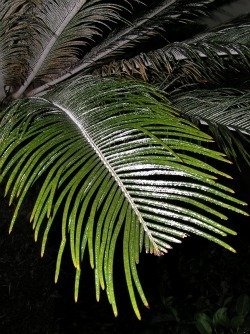
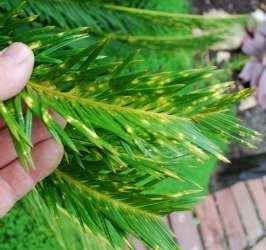
snow- like material on cycad leaf- scale (left); scale damage on this rare form of Cycas revoluta with forked leaflets (right)
However spider mites and mealy bugs can also be problematic for Cycas revolutas, particularly those grown indoors are in deep shade. Shade is the mealy bug's friend and they take advantage of lack of sunlight in many ornamental plants. These bugs particularly like new growth and can permanently damage or kill the new leaves. Spider mites are primarily and indoor or greenhouse problem and love plants growing where there is no air flow. Spider mites leave a fine webbing on the underside of the leaflets and a yellowing to spotting on top. Treat routinely with miticide and increase air flow from now on.
Sooty mold is not really a disease, but an annoying condition in which the leaves are coated with a dark, unattractive mold that grows on the materials oozed from insects that are problematic (primarily mealy bugs in the case of Cycas revoluta). The mealy bugs are in turn brought to these plants by ants. So ultimately, if one wants to get rid of sooty mold, one needs to control ant infestations. Cleaning off sooty mold requires some detergents usually as it is held in place by some really sticky stuff, and just wiping it off is not always that easy.
However, in general, these plants are pretty problem free and among the easiest of the ornamentals to grow and keep looking perfect, even in marginal climates.
For more on the care and cultivation of Cycas revolutas see the following links:
http://www.junglemusic.net/cycadadvice/cycads-sago-palm.htm
http://www.rhapisgardens.com/sagos/
For more information on cycads in general, see these links:
http://davesgarden.com/guides/articles/view/41/
http://davesgarden.com/guides/articles/view/1442/
http://plantnet.rbgsyd.nsw.gov.au/PlantNet/cycad/
Copyright © www.100flowers.win Botanic Garden All Rights Reserved